
Article Summary: Arkansas Landmarks
Arkansas Landmarks. More Than Just Parks has 15 incredible must-see sites for you to visit.
There’s so much more to this exciting place than the Arkansas Razorbacks. In this article, we’ll familiarize you with the incredible landmarks located in The Natural State.
We’ve got incredible places, iconic memorials, fascinating museums, epic monuments and so much more.
We’re going to give you our list of the Top 15 Landmarks In Arkansas.
So, What Is A Landmark?
Well, it’s a place of “a special character or special historical or aesthetic interest or value as part of the development, heritage, or cultural characteristics of a city, state, or nation.”
Why visit these places? Because landmarks connect us to the past. Through visiting these wonderful places where history occurred we find our roots. It allows us to feel like we are a part of something much bigger than ourselves.
And, speaking of history, did I mention that I taught the subject? I spent a lifetime teaching about the history behind many of these amazing sites. Then I got to see them firsthand. And now I’m sharing the fascinating stories of these places with you. It doesn’t get any better than that!
So, without further ado, let’s dive in.
Table of Contents: Arkansas Landmarks
Arkansas Landmarks
Some Fascinating Facts About Arkansas
Here’s some fascinating facts:
- Geographic Diversity: Arkansas is known for its diverse geography. It features the Ozark Mountains in the northern part of the state and the Ouachita Mountains in the west. The Mississippi River forms the eastern border, and the state is also home to numerous lakes, rivers, and forests.
- Hot Springs National Park: Located in the city of Hot Springs, Arkansas, it is the oldest national park established for the protection of a natural resource. The park is famous for its naturally heated thermal springs, which were believed to have healing properties by Native American tribes and early European settlers.
- Crater of Diamonds State Park: This unique state park, located near Murfreesboro, is the only diamond-producing site open to the public in the world. Visitors can search for diamonds and other gemstones in a designated search area and keep what they find.
- Bill Clinton’s Birthplace: Arkansas is the birthplace of the 42nd President of the United States, Bill Clinton. His childhood home in Hope, Arkansas, has been preserved and is now a National Historic Site, attracting visitors interested in learning about his early life.
- Natural Bridge: Arkansas is home to the largest natural bridge in the state, aptly named Natural Bridge. Located in the Ozark National Forest, this impressive rock formation stretches 188 feet long and 35 feet high. It is a popular destination for hikers and nature enthusiasts.
- Walmart’s Headquarters: Bentonville, Arkansas, is the birthplace of Walmart, one of the largest retail corporations in the world. The original Walmart store, known as “Walmart Museum,” is located in Bentonville and showcases the company’s history and evolution.
- The Buffalo National River: Designated as America’s first national river, the Buffalo National River flows through the picturesque Ozark Mountains. It offers visitors opportunities for canoeing, fishing, camping, and hiking, providing a beautiful escape into nature.
- Unique Cuisine: Arkansas has a diverse culinary scene with some unique dishes. One notable example is the deep-fried pickles, which are a popular snack in the state. Other local favorites include fried catfish, smoked meats, and traditional Southern comfort food.
- Historic Civil Rights Moments: Arkansas played a significant role in the civil rights movement. The Central High School in Little Rock gained national attention in 1957 when nine African American students, known as the “Little Rock Nine,” enrolled in the previously all-white school, facing significant opposition. This event highlighted the struggle for desegregation in public schools.
- Natural Beauty: Arkansas is known as “The Natural State” due to its abundance of natural beauty. From the majestic waterfalls of the Ozarks to the stunning fall foliage along the scenic drives, the state offers breathtaking landscapes and outdoor recreational opportunities.
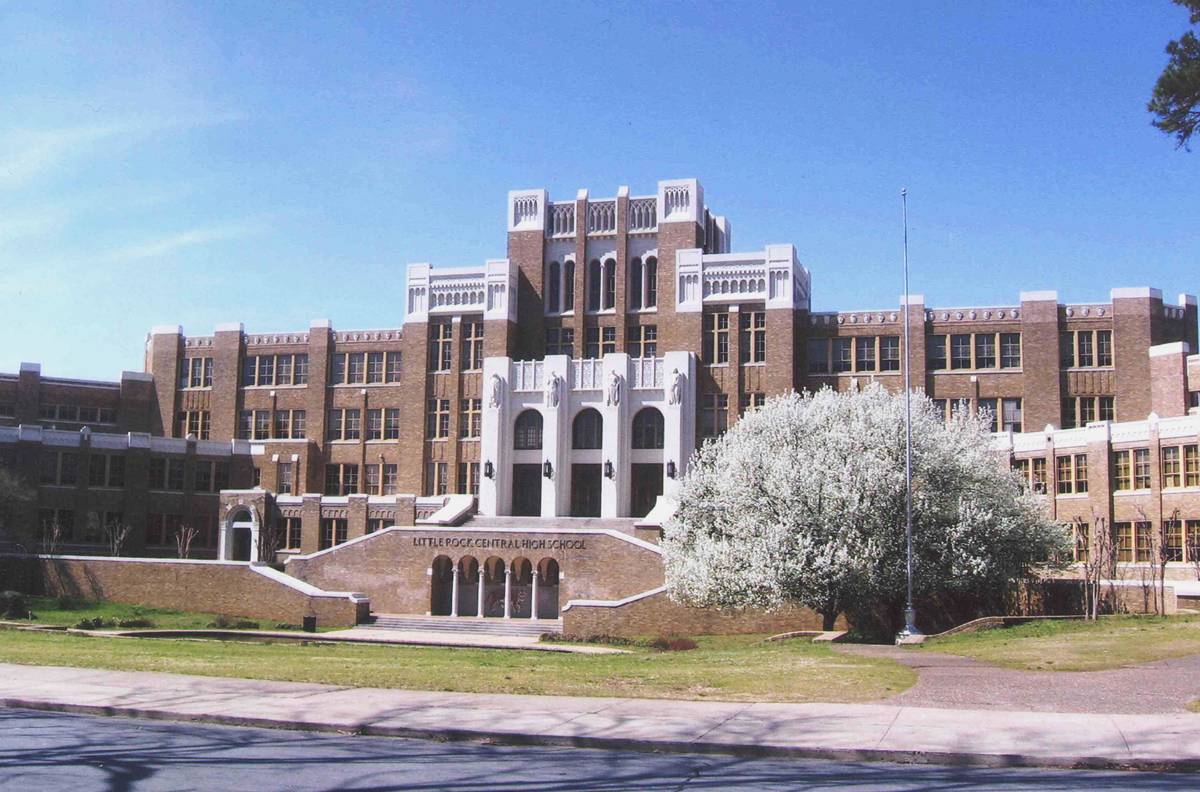
Central High School, Little Rock, Arkansas | Courtesy of NPS
Top 15 Arkansas Landmarks
15. Crystal Bridges Museum of American Art
Arkansas is known for in a state full of beautiful lakes and state parks, Hot Springs’ downtown history, Arkansas fishing, culinary delights, and of course, Johnny Cash.
It’s also home to some amazing landmarks. At More Than Just Parks, we’re going to share our list of the Top 15 Arkansas Landmarks with you. And, we’re kicking off our list at #15 with the Crystal Bridges Museum of American Art.
The museum is nestled in a beautiful 120-acre wooded landscape, which includes natural springs and walking trails. The architectural design of the museum seamlessly integrates with the surrounding environment, creating a harmonious blend of art and nature.
Crystal Bridges is dedicated to showcasing American art spanning five centuries. Its collection features more than 5,000 artworks, including paintings, sculptures, photographs, and installations. The artworks represent a diverse range of styles and periods, from Colonial times to contemporary works.

Crystal Bridges Museum of American Art | Courtesy of Wikimedia Commons
An Impressive Collection
The museum boasts an impressive collection of iconic American artworks. Visitors can admire renowned pieces such as Asher B. Durand’s “Kindred Spirits,” Norman Rockwell’s “Rosie the Riveter,” and Georgia O’Keeffe’s “Jimson Weed/White Flower No. 1.” These artworks, among many others, represent the richness and diversity of American artistic expression.
Crystal Bridges’ striking architecture was designed by world-renowned architect Moshe Safdie. The museum’s buildings feature curved lines, natural materials, and extensive use of glass, allowing visitors to enjoy the surrounding natural beauty while experiencing the art within.
The museum encompasses various exhibition spaces, including the Great Hall, the Temporary Exhibition Galleries, and several smaller galleries. It also houses an auditorium, classrooms, a library, a restaurant, and a museum store, providing visitors with a comprehensive cultural experience.
The museum’s grounds feature an extensive collection of outdoor sculptures, seamlessly blending art with the natural environment. Visitors can explore the trails and encounter stunning works by artists such as Mark di Suvero, Dale Chihuly, and Robert Indiana.
14. Parkin Archeological State Park
Our next Arkansas landmark is a significant historical site located in Parkin, Arkansas. At #14 on our list of the Best Arkansas Landmarks is Parkin Archeological State Park.
Parkin Archeological State Park preserves the remnants of an ancient Native American village that thrived during the Mississippian period (AD 1000-1600). The site provides insights into the culture and daily life of the indigenous peoples who inhabited the region over 500 years ago.
The park centers around the Parkin Site, a designated National Historic Landmark. This site was once a fortified village known as Casqui, believed to have been a chiefdom and important trading center in the Mississippi River Valley.

Parkin Archeological State Park | Courtesy of Wikimedia Commons
There’s A Preserved Mound Complex
At the heart of the Parkin Site, visitors can explore a preserved mound complex. The largest mound, known as Mound A, stands 15 feet tall and covers the remains of a ceremonial structure. The mounds offer a glimpse into the architectural and ceremonial practices of the Mississippian people.
Excavations at Parkin have yielded numerous artifacts and insights into the daily life of the Mississippian inhabitants. These findings include pottery, tools, jewelry, and evidence of farming and trade networks. The discoveries help archeologists piece together the history and cultural practices of the ancient village.
The park features a visitor center that offers exhibits and interpretive displays about the site’s history and archeological significance. Visitors can learn about the Mississippian culture, view artifacts, and explore interactive exhibits that bring the past to life.
A paved trail winds through the park, allowing visitors to explore the site’s various features and learn about the village’s layout and structures. Along the trail, interpretive signs provide historical context and information about the archeological finds.
Parkin Archeological State Park hosts educational programs, workshops, and special events throughout the year. These activities range from guided tours and lectures to hands-on demonstrations of Native American crafts, providing visitors with opportunities to engage with the site’s history.

Parkin Archeological State Park in Parkin, Arkansas | Courtesy of Wikimedia Commons
13. Arkansas Inland Maritime Museum
Our next Arkansas landmark is a captivating museum located in North Little Rock, Arkansas. At #13 on our list of the Best Arkansas landmarks is the Arkansas Inland Maritime Museum.
The Arkansas Inland Maritime Museum is dedicated to preserving and showcasing the maritime history of the United States, with a particular focus on the naval forces. It provides visitors with an opportunity to explore and learn about the naval vessels that played significant roles in American military history.
The centerpiece of the museum is the USS Razorback, a Balao-class submarine that served in World War II, the Korean War, and the Vietnam War. Visitors can tour the submarine and gain insights into the daily life of submariners and the challenges they faced during wartime.
The museum houses a remarkable collection of naval artifacts and exhibits related to submarine warfare and naval history. These include torpedoes, naval weaponry, uniforms, personal memorabilia, and historical documents that provide a comprehensive understanding of the naval experience.
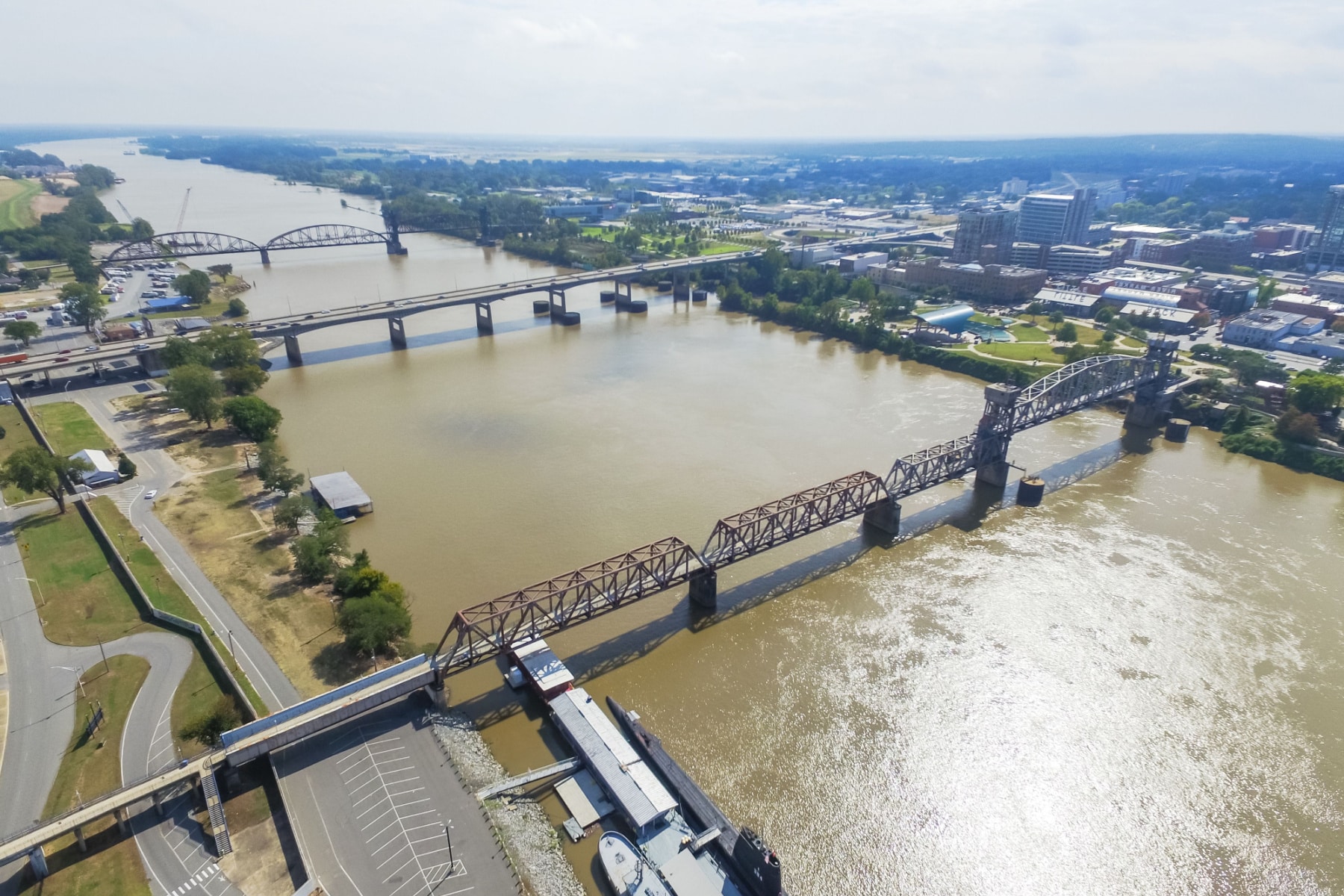
Interactive Exhibits
The museum features interactive exhibits that engage visitors of all ages. Interactive displays allow visitors to experience simulated submarine dives, learn about sonar technology, and understand the intricate workings of submarine systems.
The Arkansas Inland Maritime Museum offers educational programs for students and visitors interested in learning more about naval history and maritime science. These programs include guided tours, lectures, and hands-on activities designed to provide an immersive and educational experience.
The museum’s location on the banks of the Arkansas River adds to its charm. Visitors can enjoy scenic views of the river and nearby downtown Little Rock while exploring the museum and its exhibits.
Adjacent to the museum, visitors will find the Submarine Veterans Memorial, a monument honoring submariners who served in the United States Navy. The memorial pays tribute to the sacrifices and contributions of these brave individuals throughout history.
The museum regularly hosts events, guest speakers, and temporary exhibits related to naval history and maritime culture. These events offer unique opportunities for visitors to delve deeper into specific aspects of naval history and broaden their knowledge.
12. Rohwer Relocation Center Memorial Cemetery
Our next Arkansas landmark explores a dark chapter in American history. At #12 on our list of the Best Arkansas Landmarks is Rohwer Relocation Center Memorial Cemetery.
The Rohwer War Relocation Center Cemetery is one of only three remaining Japanese American relocation cemeteries, and serves as a reminder of the forced internment of Japanese Americans during World War II.
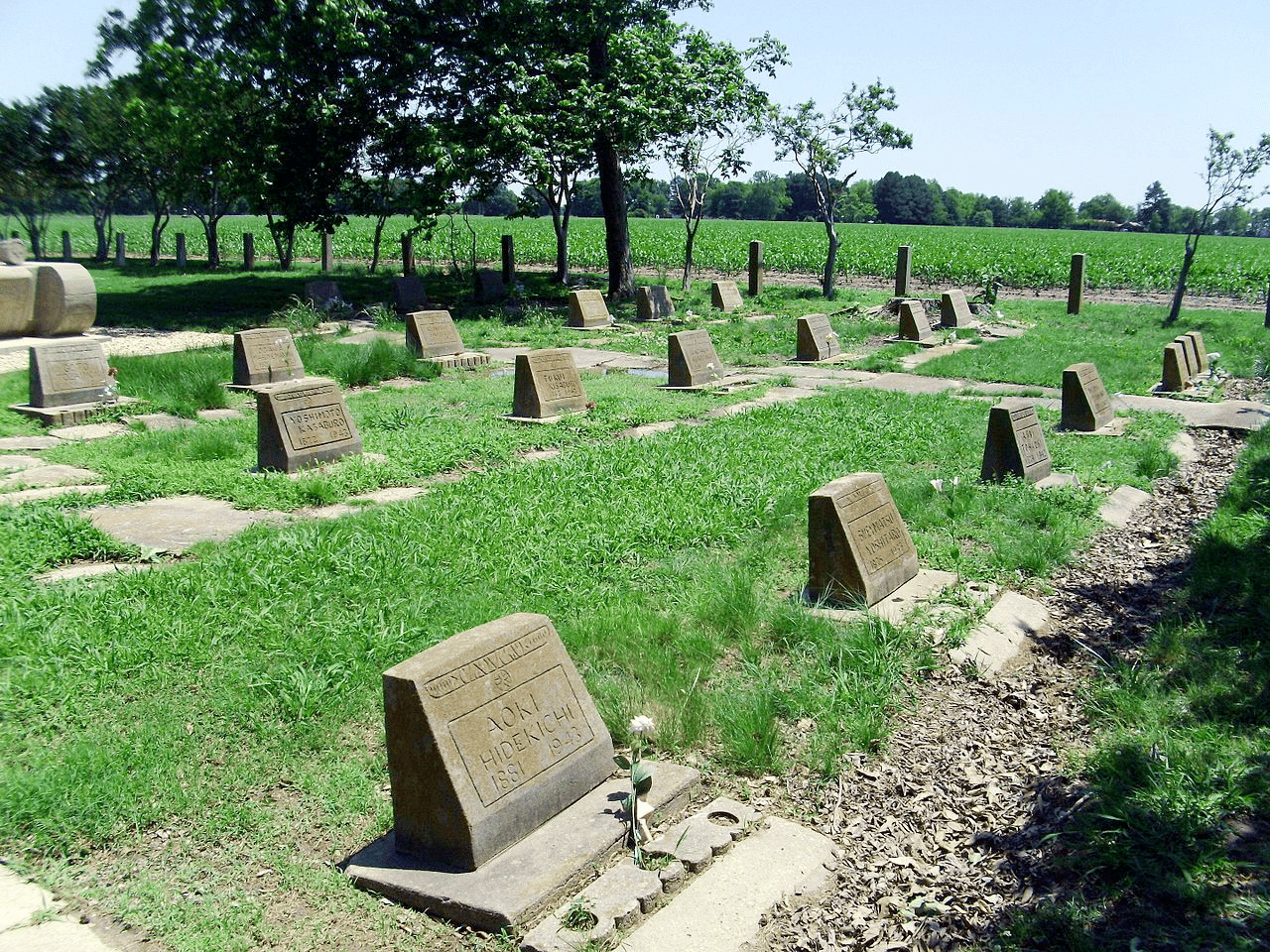
A Dark Chapter In American History
The U.S. government, under President Franklin D. Roosevelt, issued Executive Order 9066, which authorized the forced removal of Japanese Americans from the West Coast.
The majority of those interned were U.S. citizens or legal permanent residents. They were sent to detention camps, often in remote and inhospitable locations, where they were housed in makeshift barracks and suffered from poor living conditions.
The internment of Japanese Americans was later acknowledged as a grave injustice by the U.S. government. In 1988, President Ronald Reagan signed the Civil Liberties Act, which formally apologized for the internment and provided reparations to surviving Japanese American internees.
The U.S. internment of Japanese Americans is considered a dark chapter in American history and serves as a reminder of the dangers of fear-based discrimination and the importance of protecting civil liberties.
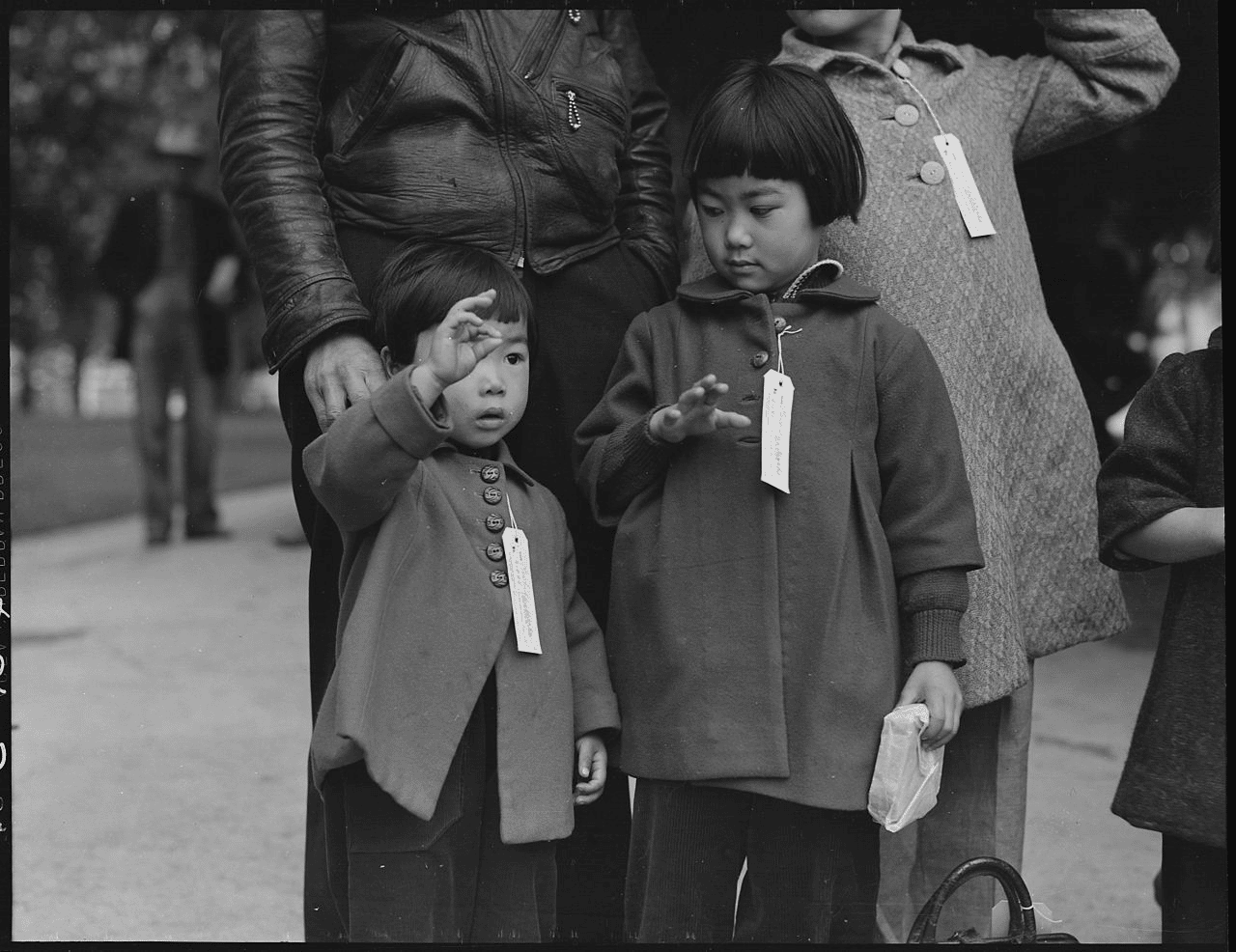
Things To Do At Rohwer Relocation Center Memorial Cemetery
Here are some of the things that visitors can see and do at the cemetery:
- Explore the cemetery and pay respects to the internees buried there
- Learn about the history of the Rohwer Relocation Center and the U.S. internment of Japanese Americans through interpretive signage and informational materials
- Take a guided tour to gain a deeper understanding of the history and significance of the site
- Attend special events and ceremonies, such as memorial services and cultural events, to commemorate the experiences of the internees
- Reflect and pay homage to those who suffered during this dark chapter in American history.
The Rohwer Relocation Center Memorial Cemetery serves as a powerful reminder of the impact of war and the importance of protecting civil liberties and human rights.
11. Louisiana Purchase State Park
We move on to a happier chapter in American history. In fact, some folks would argue that it’s the story of the greatest real estate deal in American history. At #11 on our list of the Best Arkansas Landmarks is The Louisiana Purchase State Park.
The Louisiana Purchase State Park is a historic site located in the town of Brinkley, Arkansas. The park is dedicated to the history of the Louisiana Purchase, a land deal between the United States and France in 1803 that doubled the size of the young nation.
The park is home to the Louisiana Purchase Historic State Park Visitor Center, which was established in 1966 to commemorate the 150th anniversary of the Louisiana Purchase. The center is located in a historic building that once served as a general store and is listed on the National Register of Historic Places.
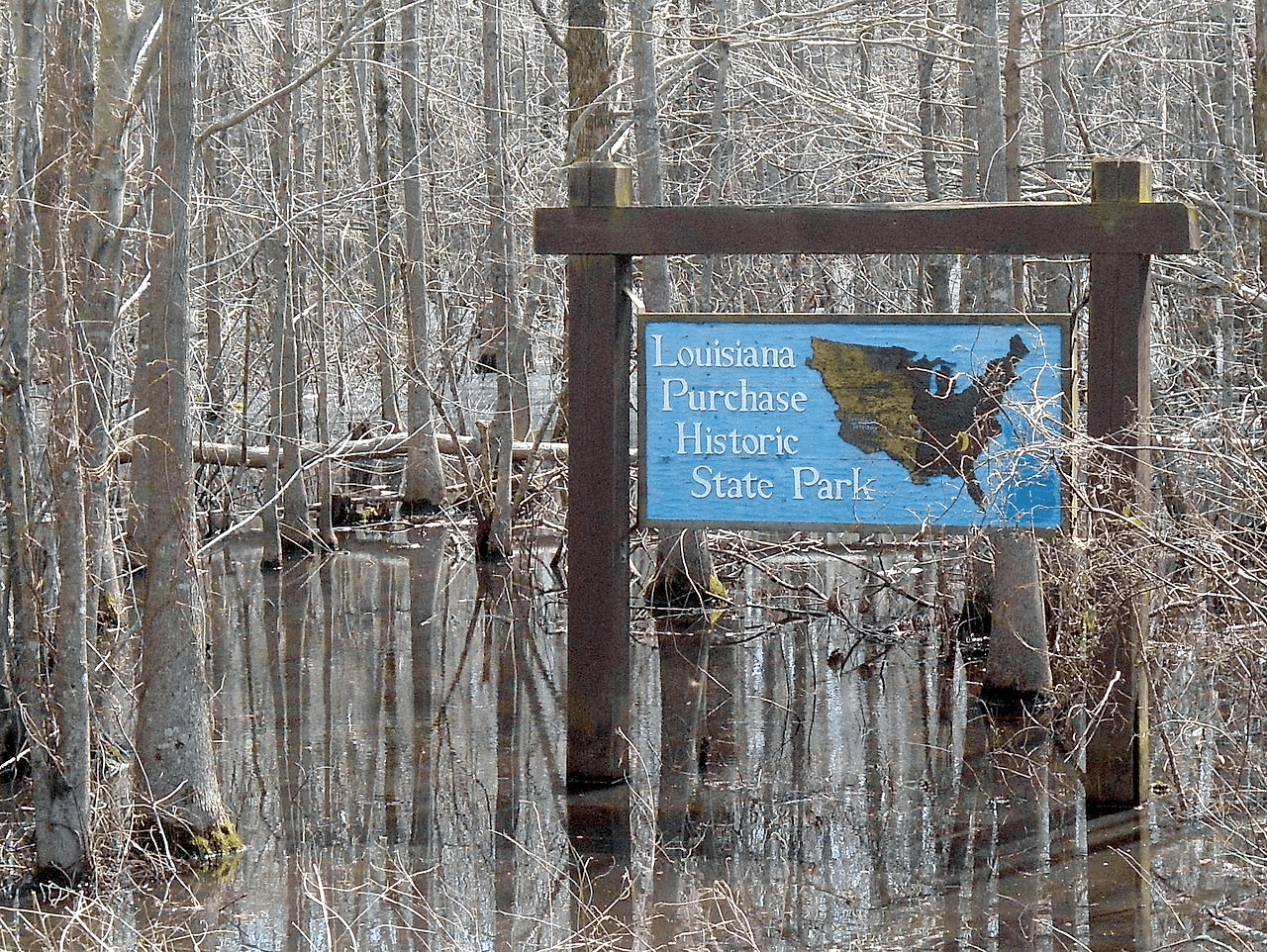
See The Artifacts & Exhibits Which Tell The Story Of The Louisiana Purchase
The Louisiana Purchase Visitor Center houses exhibits and artifacts that tell the story of the Louisiana Purchase and its impact on the United States. Visitors can see original documents and maps from the time period and learn about the negotiations that led to the purchase of the Louisiana Territory from France.
In addition to the visitor center, the Louisiana Purchase State Park also includes a portion of the St. Francis River, which served as a boundary between the United States and the Spanish colony of Louisiana before the Louisiana Purchase.
Visitors can explore the river by canoe or kayak and see the natural beauty of the area, including the unique hardwood forests and wetlands.
The Louisiana Purchase State Park is the only state park in Arkansas dedicated solely to the history of the Louisiana Purchase. It serves as an important educational resource for visitors of all ages and a reminder of the significant impact that this historic event had on the development of the United States.
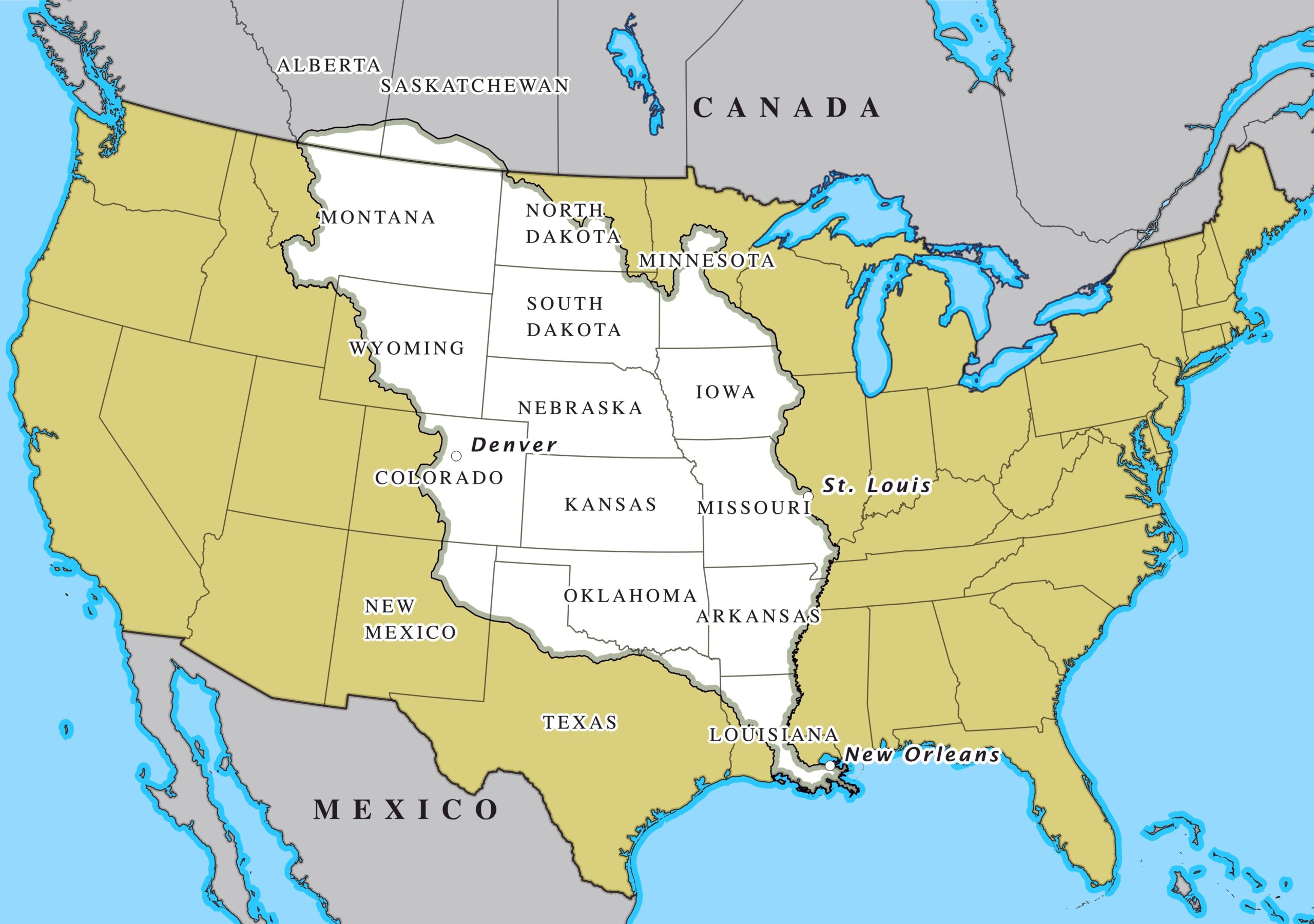
Map of the Louisiana Purchase | Courtesy of Wikimedia Commons
Top 10 Arkansas Landmarks
10. Toltec Mounds Archaeological State Park
We’re on to our Top 10 Arkansas Landmarks. If you enjoy ancient history then you’ll love our next site. At #10 on our list is the Toltec Mounds Archaeological State Park.
The Toltec Mounds Archaeological State Park is a historic site located in the town of Scott, Arkansas. The park is dedicated to the preservation and interpretation of the Toltec Mounds, a complex of prehistoric earthworks and mounds that date back to the Mississippian Period.
The Toltec Mounds were built by a culture known as the Plum Bayou people between the 8th and 11th centuries CE. The mounds were used for ceremonial and religious purposes and were likely the center of a large population center that spanned several hundred acres.
The Toltec Mounds were first identified by European explorers in the 17th century, and in the years that followed, they were subject to various forms of excavation and study. In the 20th century, the state of Arkansas acquired the land surrounding the mounds and established the Toltec Mounds Archaeological State Park in 1978.
Today, the Toltec Mounds Archaeological State Park is home to a museum and visitor center that showcases artifacts and exhibits related to the Plum Bayou culture and the Toltec Mounds. Visitors can explore the mounds and learn about the methods and tools used by the Plum Bayou people to construct these impressive earthworks.
The park also hosts various events and programs throughout the year, including guided tours, lectures, and special exhibits. The Toltec Mounds Archaeological State Park is a unique and important site in the history of Arkansas and the United States and serves as an important educational resource for visitors of all ages.
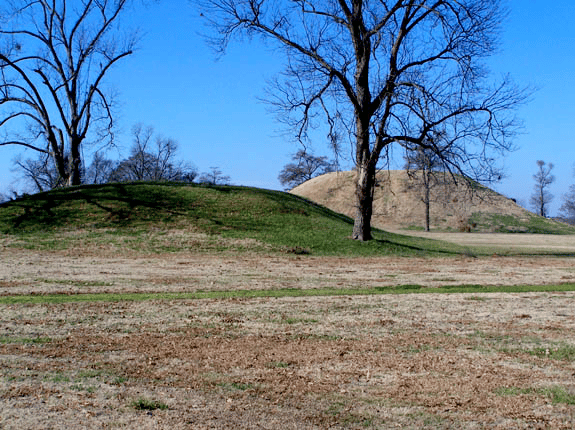
9. Blanchard Springs Caverns
Our next Arkansas landmark is the only cave administered by the U.S. Forest Service. It’s considered one of the most beautiful in the country. At #9 on our list of the Best Arkansas Landmarks is Blanchard Springs Caverns.
Blanchard Springs Caverns consist of three levels that visitors can explore: the Dripstone Trail, the Discovery Trail, and the Wild Cave Tour. Each level offers a unique experience and showcases different geological formations within the cave system.
The Dripstone Trail is a well-lit, paved path that guides visitors through the main part of the caverns. It features stunning formations such as stalactites, stalagmites, columns, flowstones, and draperies. The trail is accessible to visitors of all ages and is accompanied by informative signage explaining the geological processes that formed the cave.
The Discovery Trail is a more adventurous option for visitors. This unlit, undeveloped trail leads visitors deeper into the caverns and provides a closer look at various formations. It requires a lantern or flashlight and sturdy footwear, as it involves maneuvering through narrower passages and uneven terrain.

A Geologic Wonder
One of the highlights of Blanchard Springs Caverns is the Crystal Dome, located along the Discovery Trail. This impressive formation is a massive column adorned with sparkling calcite crystals, creating a breathtaking sight.
Inside the caverns, visitors will encounter the underground Mirror Lake, which reflects the stalactites and formations above it, creating a magical visual effect. The flowing waters of the underground river add to the enchantment of the cavern experience.
The Cathedral Room is the largest single cave room in Blanchard Springs Caverns, measuring approximately 200 feet long and 100 feet wide. It features towering columns, massive flowstones, and intricate formations that showcase the grandeur of the cave system.
The caverns offer guided tours led by knowledgeable park rangers who provide fascinating insights into the geology, history, and ecology of the caves. These tours enhance the visitor experience and offer a deeper understanding of the natural processes that shaped Blanchard Springs Caverns.
In addition to the caverns, the surrounding area offers outdoor recreational opportunities. Visitors can enjoy hiking trails, picnicking, and camping in the scenic Ozark-St. Francis National Forest, immersing themselves in the natural beauty of the region.
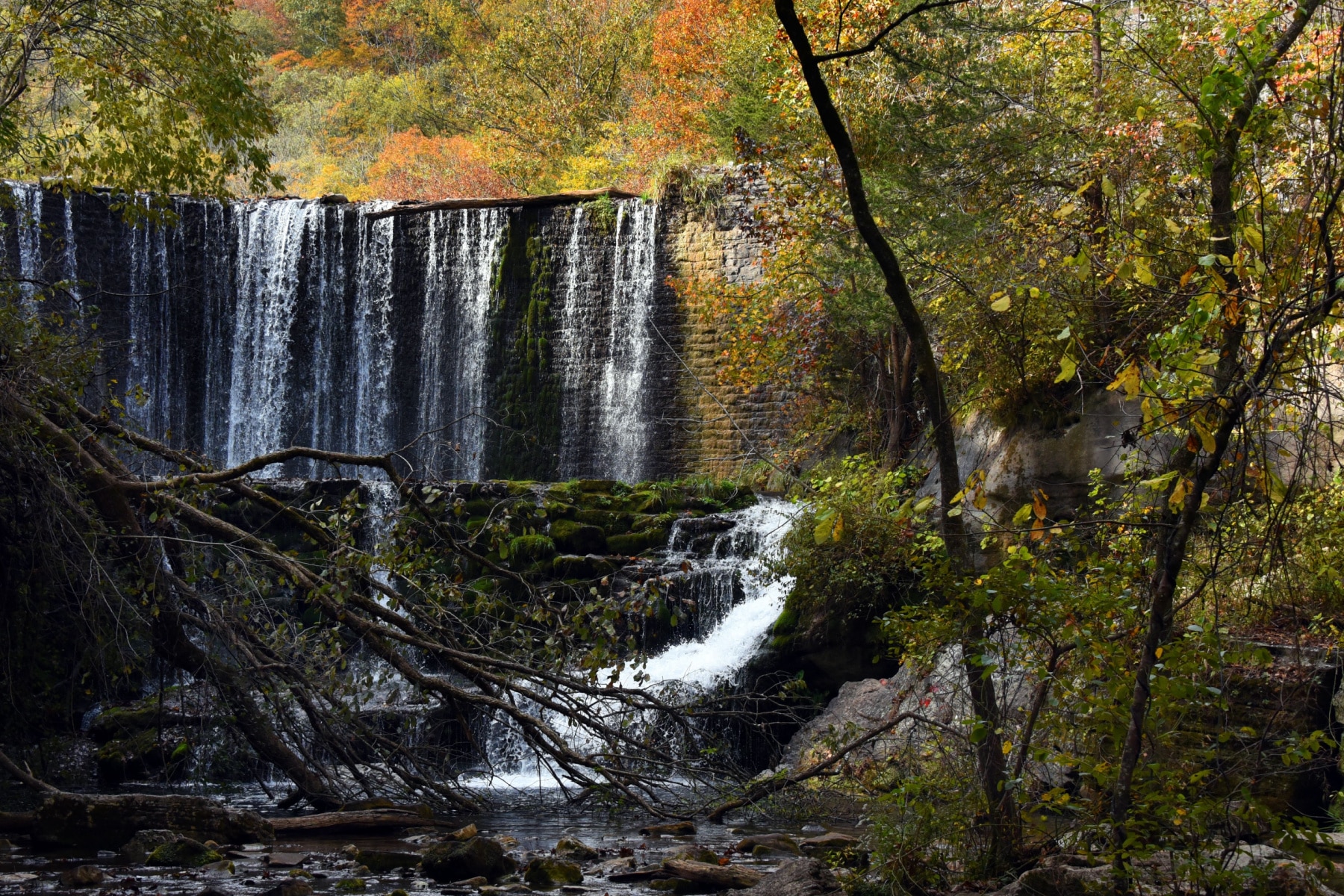
8. Arkansas Post National Memorial
Our next landmark commemorates the first European settlement in the lower Mississippi River Valley. At #8 on our list of the Best Arkansas Landmarks is the Arkansas Post National Memorial.
The Arkansas Post National Memorial is located in Gillett, Arkansas. It commemorates the history of the Arkansas Post, which was the first European settlement in the lower Mississippi River Valley.
The settlement was established by the French in 1686 and was an important center of trade, diplomacy, and military activity for more than a century.
The memorial includes a visitor center with exhibits about the history of the Arkansas Post, as well as a trail that leads to the remnants of the original fortifications.
The site is listed on the National Register of Historic Places and is managed by the National Park Service.
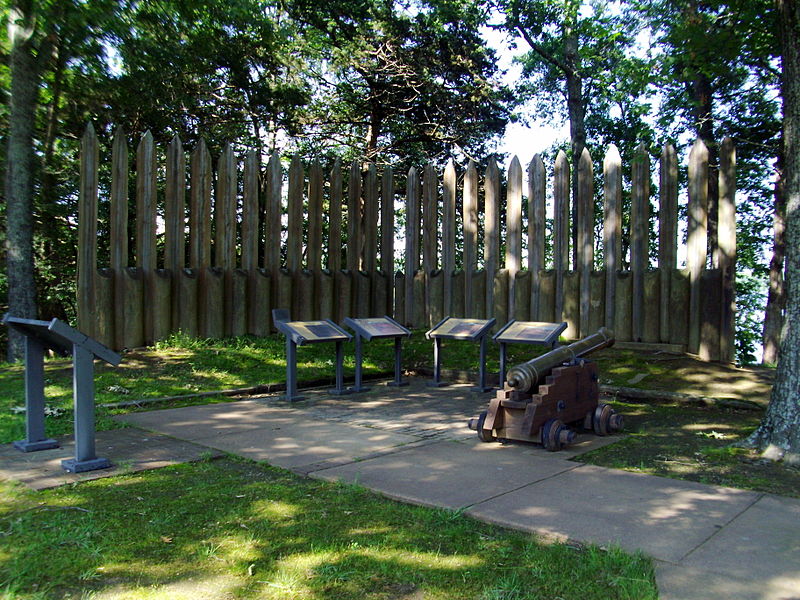
Things To See & Do At The Arkansas Post
Here are some of the things visitors can see and do at the Memorial:
- Explore the museum exhibits to learn about the history of the Arkansas Post and its significance
- Take a guided tour of the historic site and learn about the experiences of the different groups that lived and worked there, including French, Spanish, and American settlers, and the Quapaw Indian tribe
- Observe the reconstructed fort and other historic structures on the grounds to get a sense of daily life at the Arkansas Post
- Participate in special events and educational programs to learn about different aspects of the history of the Arkansas Post and its significance
- Hike the trails and enjoy the natural beauty of the Mississippi River bottomland forest.
The Arkansas Post National Memorial is an important cultural and historical site that offers visitors a unique opportunity to learn about the diverse experiences and histories of the people who lived and worked in Arkansas.
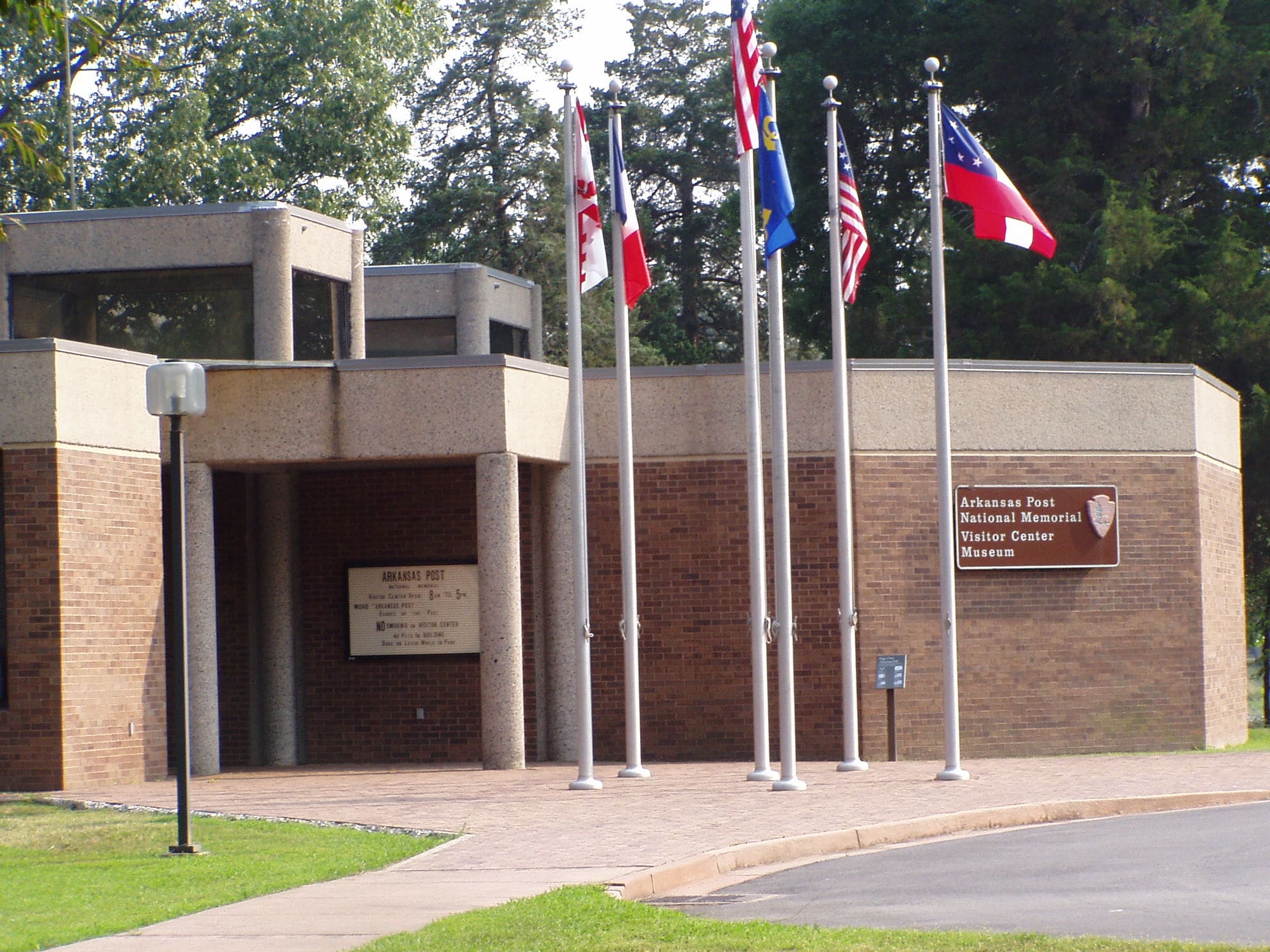
7. Fort Smith National Historic Site
We’re on to our Top 7 Historic Sites In Arkansas. If you enjoy military history then our next site is for you as it site preserves the remains of two 19th-century military forts. At #7 we have Fort Smith National Historic Site.
Fort Smith National Historic Site is located in Fort Smith, Arkansas. The site preserves the remains of two 19th-century military forts, Fort Smith and Fort Arbuckle, which played a key role in the military history of the western United States.
The forts were established in the 1830s and 1840s to help control the western frontier and protect settlers from Native American attacks.
The site also includes a number of other historical buildings and sites, such as the Federal Court, where Judge Isaac Parker presided over the famous “Hanging Judge” trials.
Visitors can tour the forts and other historical buildings, as well as see exhibits on the history of the area and the people who lived there. There are also guided tours and ranger-led programs available.
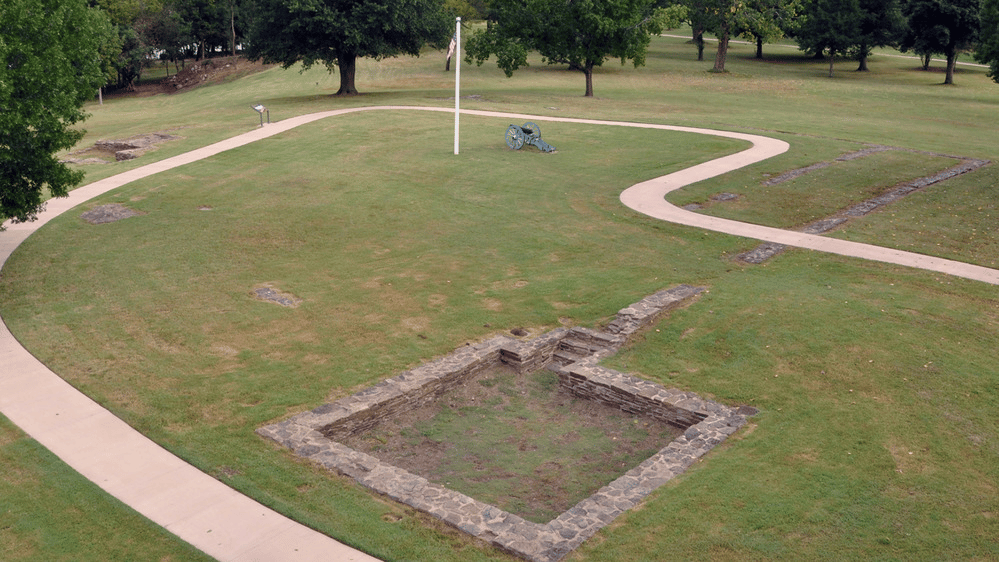
How Did Fort Smith Get Its Start
So, how did this fort get its start? At the dawn of the nineteenth century, a group of Cherokees moved into the Arkansas Territory. This happened to be the home of the Osage. You know where this is going, don’t you.
Conflict erupted between these two Native American tribes which prompted the U.S. Government to establish Fort Smith on December 25, 1817.
The fort’s goal was to maintain law and order during America’s westward expansion. It was designed by Major Stephen H. Long and built by Major William Bradford.
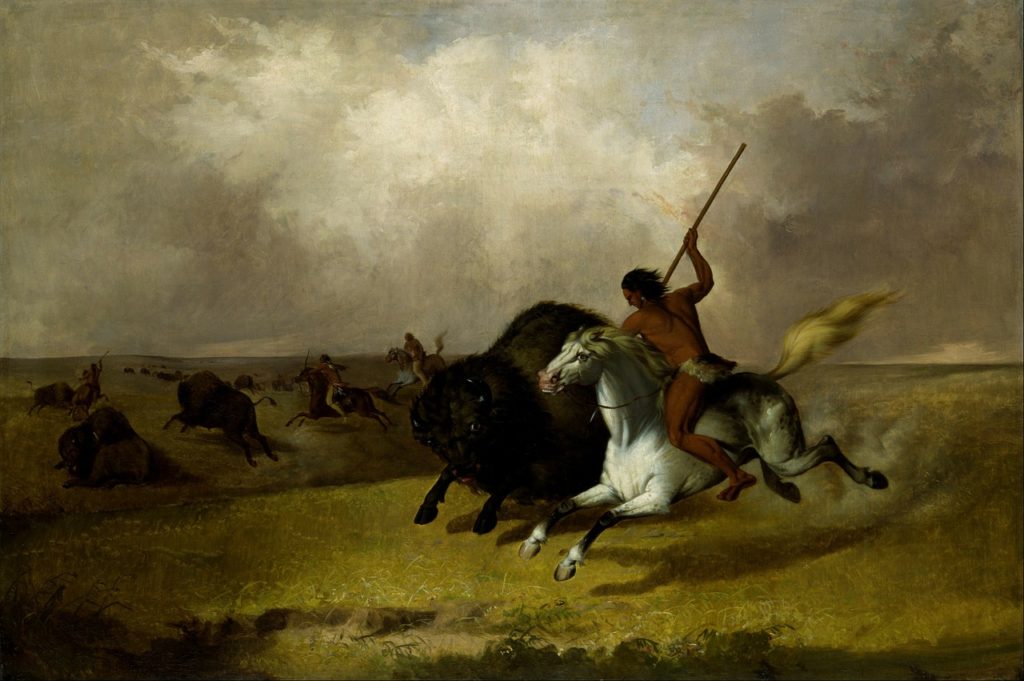
Conflict erupted between these two Native American tribes which led to the establishment of Fort Smith | Courtesy of Wikimedia Commons
6. Crater Of Diamonds State Park
Our next Arkansas landmark is a unique and renowned park located in Murfreesboro, Arkansas. Welcome to Crater of Diamonds State Park.
Crater of Diamonds State Park is the only diamond-producing site in the world that is open to the public. Visitors have the opportunity to search for diamonds and other gemstones within the 37.5-acre plowed field known as the “diamond search area.” Any diamonds or other valuable gemstones found on the site can be kept by the visitors.
The park’s main attraction is a volcanic crater, which was created by an ancient volcanic eruption over 100 million years ago. The volcanic activity brought diamonds and other precious stones to the surface, making the area highly mineral-rich.
Visitors are encouraged to bring their own tools and equipment for diamond hunting, including shovels, screens, and buckets. The park provides basic equipment for rent as well. Techniques such as dry sifting, wet sifting, and surface searching are commonly employed by visitors to increase their chances of finding diamonds.
he park’s visitor center serves as a hub of information and resources for diamond hunters. It offers exhibits on the geology of diamonds, the history of the area, and showcases notable diamonds discovered in the park. Visitors can also attend educational programs and watch videos about diamond prospecting.

A panoramic view of the field in Crater of Diamonds State Park | Courtesy of Wikimedia Commons
Diamond Discoveries
Over 33,000 diamonds have been discovered in the park since its establishment as a state park in 1972. The largest diamond ever found in the United States, the “Uncle Sam Diamond” weighing 40.23 carats, was discovered here. Other notable finds include the “Strawn-Wagner Diamond,” a flawless, 3.09-carat stone that was cut into a stunning gem.
While diamonds are the primary attraction, the park is also known for its other gemstones. Visitors have found colorful gemstones such as amethyst, garnet, jasper, and quartz in addition to diamonds. It adds an extra layer of excitement to the gem-hunting experience.
Crater of Diamonds State Park offers scenic nature trails where visitors can enjoy the surrounding beauty of the park. Picnic areas are available for visitors to relax, have meals, and take a break from diamond hunting.
The park provides amenities such as a campground, gift shop, and a water park with a swimming pool, making it a family-friendly destination. Camping overnight in the park allows visitors more time to explore and increase their chances of finding precious gemstones.

The Uncle Sam Diamond | Courtesy of Wikimedia Commons
Top 5 Arkansas Landmarks
5. Pea Ridge National Military Park
We’re on to our Top 5 Arkansas landmarks. Our next site preserves an important Civil War battlefield. At #5 on our list of the Best Arkansas Landmarks is Pea Ridge National Military Park.
The park preserves the site of the Battle of Pea Ridge, which was fought in 1862 during the American Civil War. The battle was fought between Union forces under the command of General Samuel Curtis and Confederate forces led by General Earl Van Dorn.
The battle was fought in the rolling hills of northwestern Arkansas and was one of the largest and most complex engagements of the Civil War fought west of the Mississippi River. The Union army was able to successfully defend against the Confederate army’s attempt to recapture control of Missouri, a key state for the Union.
The battle was characterized by intense and fluid combat, with both sides maneuvering and fighting for advantage. The Confederate army launched a surprise attack on the Union’s right flank on the first day of the battle, but the Union was able to regroup and counterattack on the second day, ultimately driving the Confederate army from the field and securing a decisive victory for the Union.
The Battle of Pea Ridge was an important Union victory that helped secure the Union’s hold on Missouri and the northwest frontier, and helped set the stage for Union victories in the Mississippi River valley later in the war.
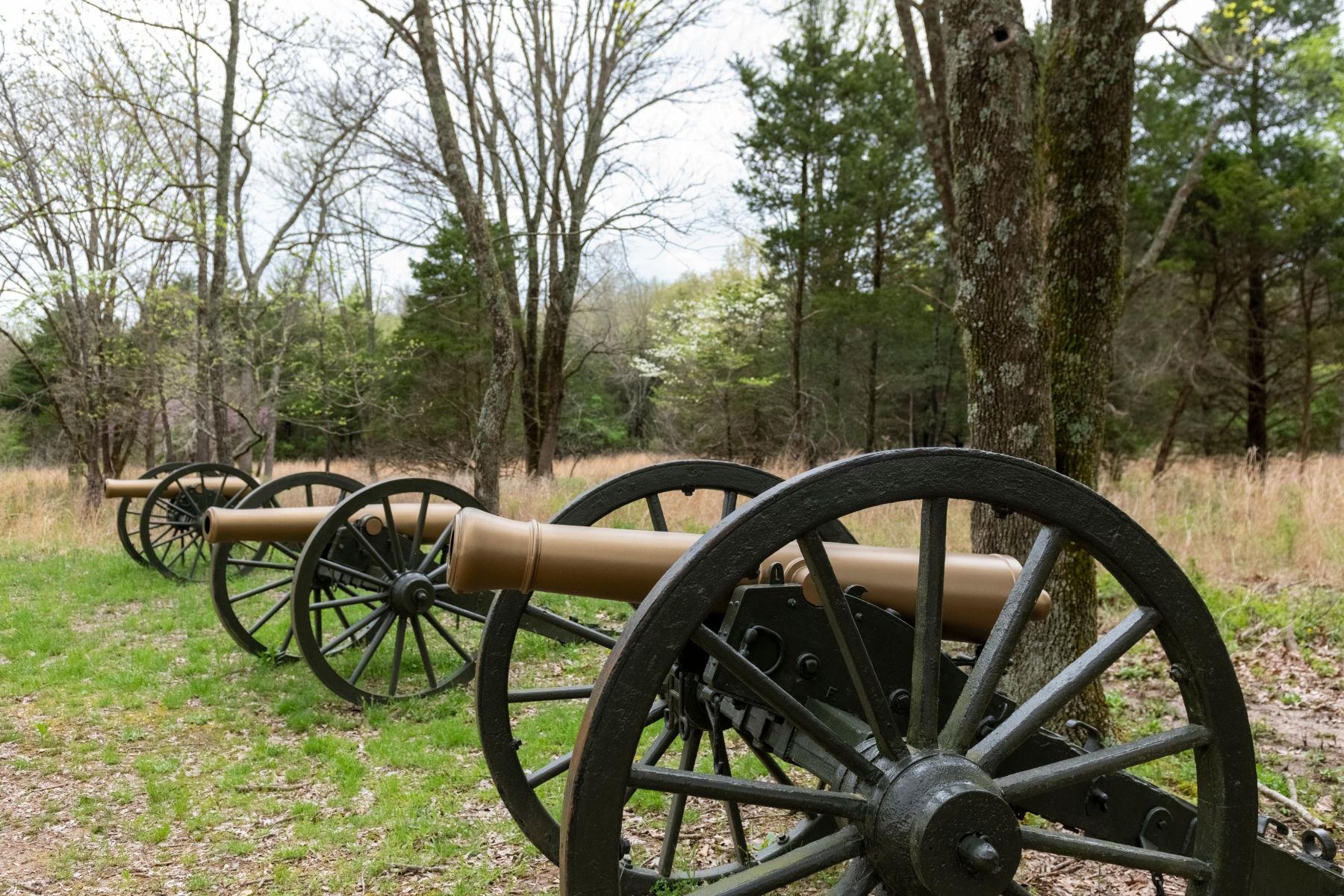
Things To See & Do
Here are some of the things visitors can see and do at the park:
- Explore the visitor center to learn about the history and significance of the battle of Pea Ridge
- Take a self-guided tour of the battlefield and see the sites where key events took place
- Walk the trails and roads to better understand the tactics and movements of the armies during the battle
- Attend interpretive programs and ranger-led tours to gain a deeper understanding of the history of the battle and its significance
- Visit the cemetery and pay respects to those who lost their lives in the battle
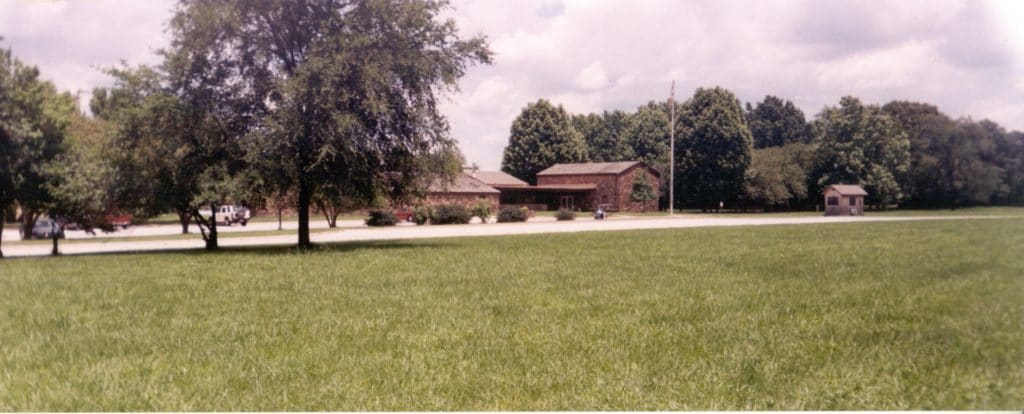
CHECK OUT: 10 BEST Civil War Sites In America
4. Buffalo National River
We’re on to our “Final Four” Arkansas landmarks. Next up is a national river located in northern Arkansas. It’s the Buffalo National River.
The river is approximately 135 miles long and flows through the Ozark Mountains, offering visitors a variety of recreational activities such as canoeing, kayaking, fishing, hiking, and swimming.
The park also includes several historic sites, such as the remains of a 19th-century mining town, and the Buffalo Outdoor Center, which offers visitors a chance to rent equipment or take guided tours.
It’s home to a diverse array of wildlife, including white-tailed deer, black bears, and elk, as well as over 200 species of birds.
The park also features scenic views of the Ozark Mountains and the river, which is known for its clear water and limestone bluffs.
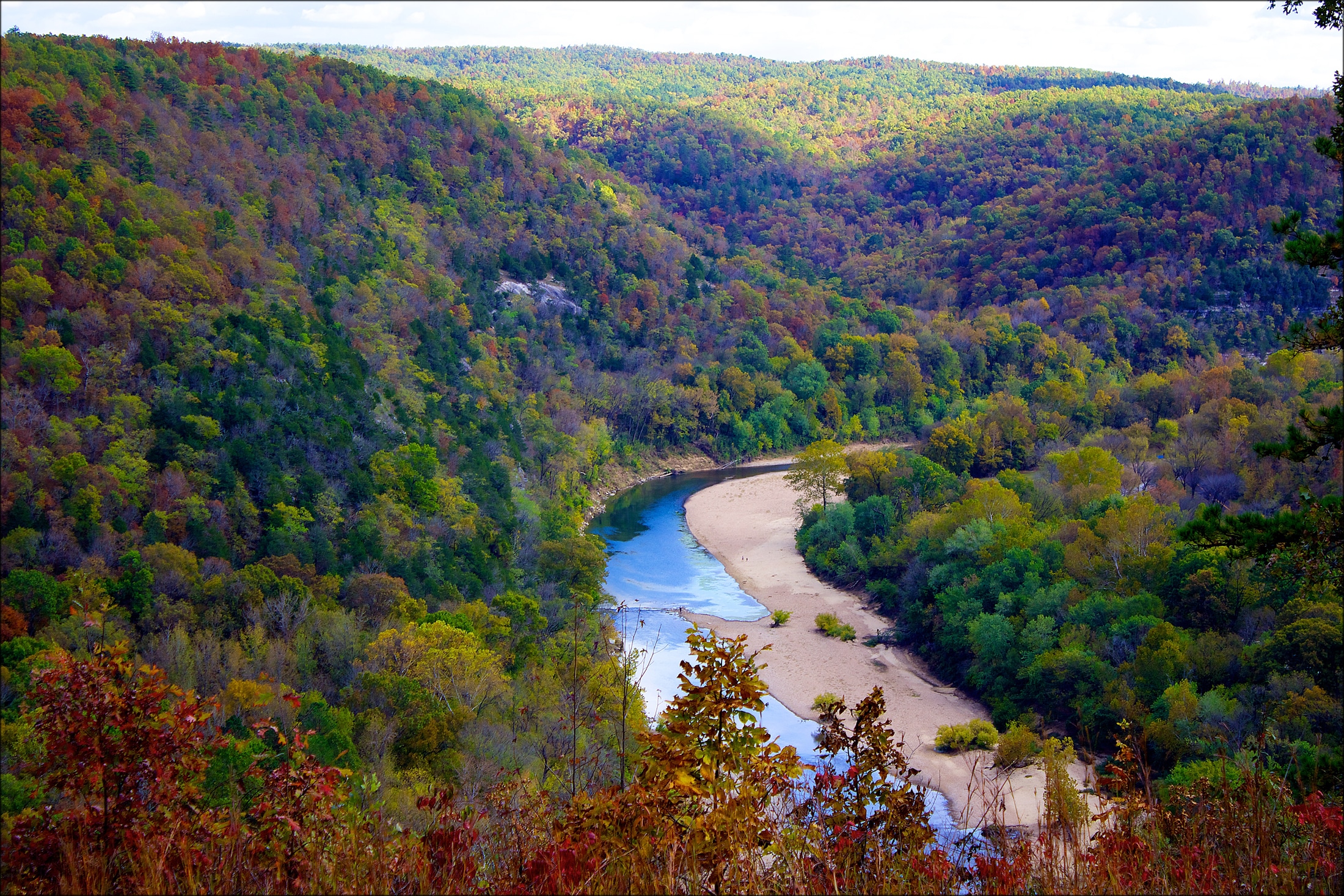
The First National River In America
In 1972, the National Park Service made the Buffalo River the first national river in America. This meant no damn.
Since that time, it’s become a popular place for camping, canoeing, fishing and hiking.
Visitors can bring their own canoes or rent them from local businesses.

3. President William Jefferson Clinton Birthplace Home National Historic Site
In the #3 spot on our list of the Best Arkansas Landmarks is a site dedicated to the only President of the United States from the state of Arkansas. It’s the President William Jefferson Clinton Birthplace Home National Historic Site.
The President William Jefferson Clinton Birthplace Home National Historic Site is located in the town of Hope, Arkansas. The site is dedicated to the preservation and interpretation of the childhood home of former President Bill Clinton, who was born in the house on August 19, 1946.
The house was built in 1917 and was purchased by Clinton’s grandparents, Eldridge and Edith Cassidy, in 1938. Clinton’s mother, Virginia Cassidy, was born in the house, and Clinton spent his first four years there before the family moved to a larger home in Hope.
After Clinton’s mother passed away in 1994, the house was donated to the National Park Service and was designated as a National Historic Site in 2011.
Today, visitors to the President William Jefferson Clinton Birthplace Home National Historic Site can tour the house and see exhibits related to Clinton’s childhood and early life in Arkansas.
The site includes a visitor center that features photographs, documents, and other artifacts related to Clinton’s life and political career.
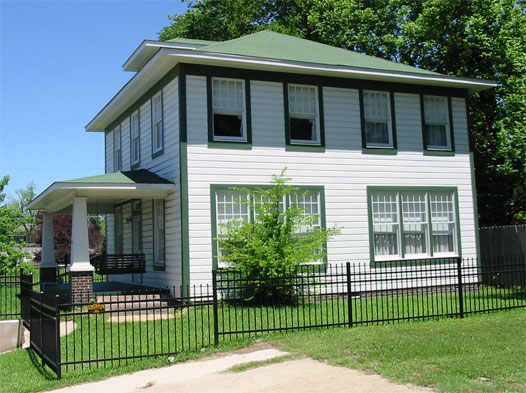
Things To Do
Here are some of the things visitors can see and do at the site:
- Explore the restored childhood home of President Bill Clinton, which has been preserved as a museum to commemorate his life and legacy
- Learn about President Clinton’s upbringing in Hope, Arkansas, and how his early experiences shaped his worldview and political philosophy
- Discover the broader context of 20th century American history, including the Civil Rights Movement, the Cold War, and the economic, political, and social changes of the era
- Take a guided tour to gain a deeper understanding of the history and significance of the site
- Attend special events and educational programs to learn about different aspects of President Clinton’s life and legacy, and the history of the region and the nation.
CHECK OUT: 25 Bucket List Famous Landmarks In America (MUST-SEE)
2. Hot Springs National Park
We’re More Than Just Parks, but that doesn’t mean that we’ve forgotten about our national parks. In the runner-up spot at #2 on our list of the Best Arkansas Landmarks is Hot Springs National Park.
Imagine a hot springs located in a national park. Why that’s Hot Springs National Park. It’s a national park located in Hot Springs, Arkansas that’sknown for its hot springs, which have been used for therapeutic and medicinal purposes for thousands of years.
The park includes several bathhouses, where visitors can bathe in the hot springs water, as well as hiking trails and scenic drives through the surrounding Ouachita Mountains.
The park also includes a number of historic buildings, such as the Fordyce Bathhouse, which was built in 1915 and served as a luxurious spa and bathhouse in the early 20th century.
Visitors can also see the Hot Springs Mountain Tower, which provides a 360-degree view of the surrounding area. The park also offers ranger-led tours and educational programs.
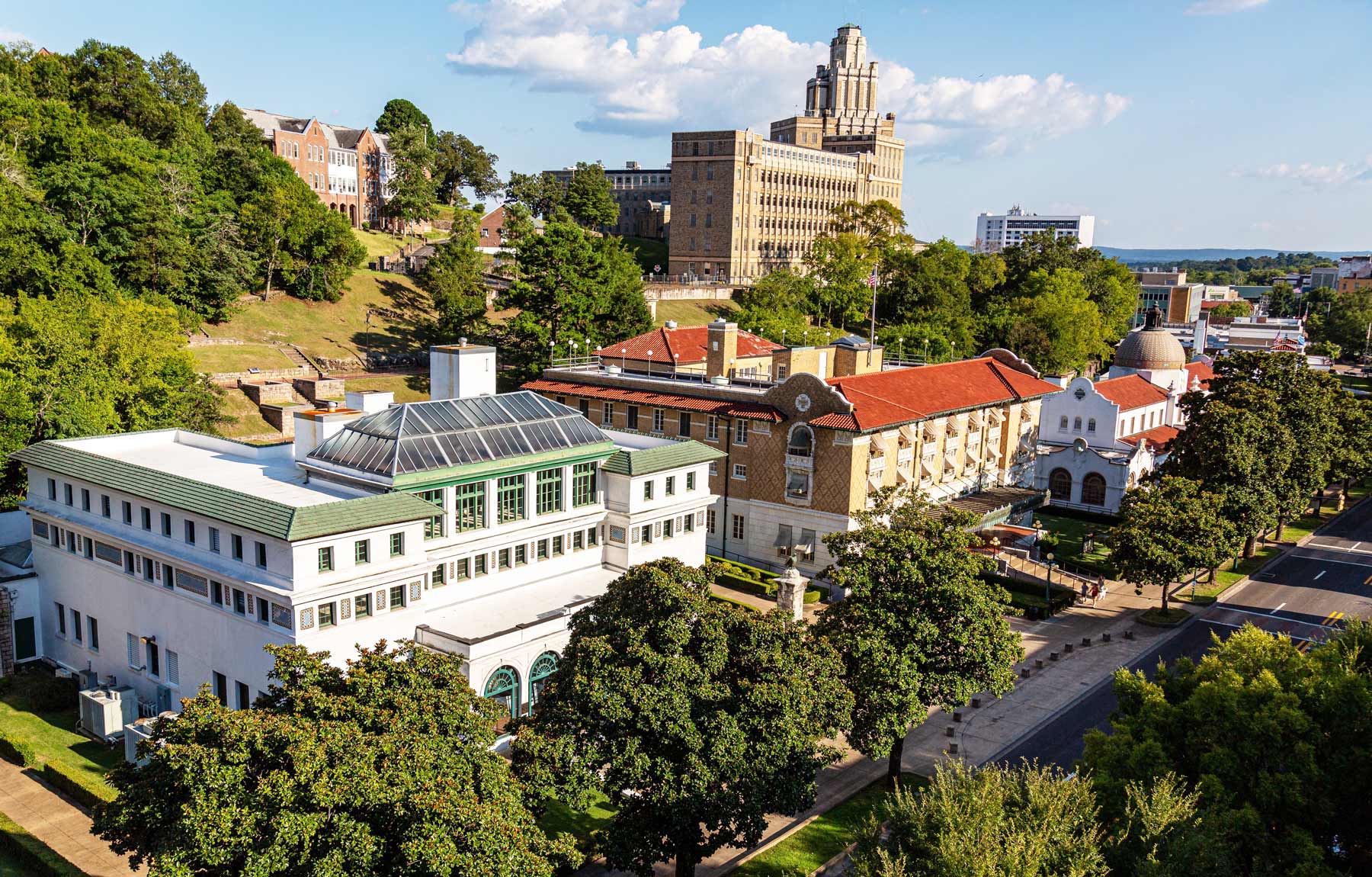
“America’s Spa”
There’s some history here too as this park is considered to be, “America’s Spa.” It includes “Bathhouse Row.” The first bathhouses were crude structures of canvas and lumber. These were little more than tents perched over individual springs or reservoirs carved out of the rock.
Keep in mind that this was before the invention of Jacuzzis.
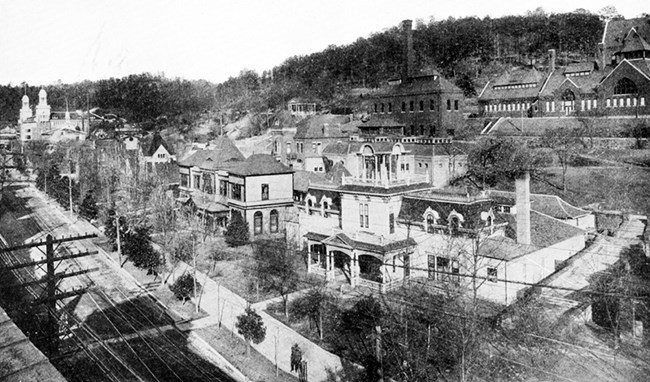
As these places increased in popularity, the original construction was replaced with the masonry and steel bathhouses that we see today.
Prominent people came to Hot Springs National Park to find healing in its soothing, warm waters. These visitors included: Al Capone, Herbert Hoover, Jesse James, Helen Keller, John F. Kennedy, Babe Ruth, and Cy Young.
You never know who’ll you meet in a bathhouse.
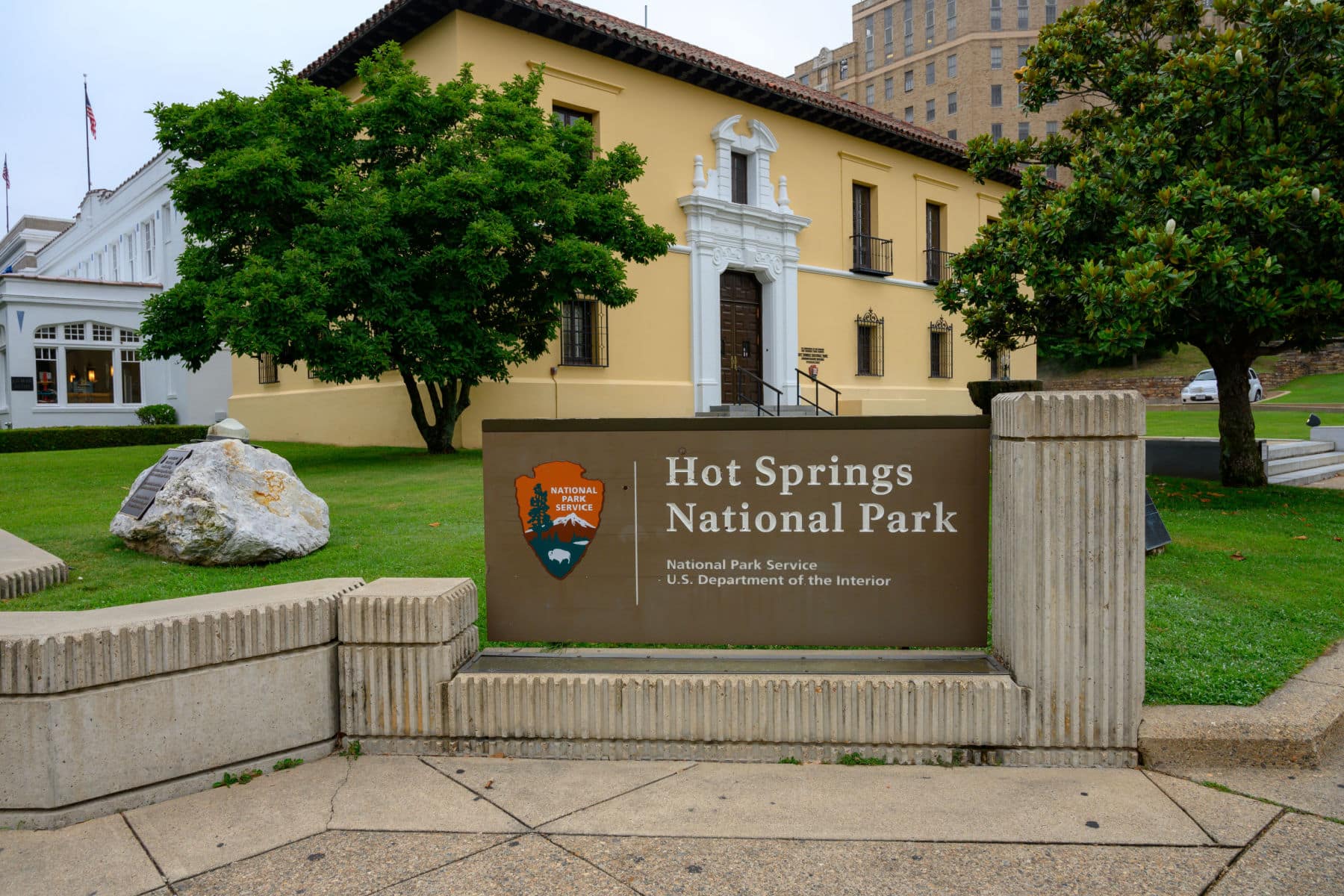
Things To See & Do
Here are some things to do at Hot Springs National Park:
- Soak in the hot springs: The park is famous for its hot springs, and visitors can take a dip in the thermal waters at several bathhouses throughout the park.
- Hike the trails: The park has over 26 miles of hiking trails that lead through the mountains and forests, offering scenic views of the area.
- Visit the Visitor Center: The Visitor Center has exhibits that showcase the history and geology of the park, as well as a gift shop and a park ranger who can answer any questions.
- Take a scenic drive: The park has a scenic drive called the Grand Promenade, which is a 1.5-mile long path that provides beautiful views of the park and the surrounding area.
- Go on a guided tour: The park offers guided tours of the historic Fordyce Bathhouse, as well as tours of the park’s hiking trails and hot springs.
- Picnic: The park has several picnic areas where visitors can enjoy a meal while taking in the beautiful scenery.
- Attend a special event: The park hosts several special events throughout the year, including nature walks, concerts, and art exhibits.
- Visit the Hot Springs Mountain Tower: The tower provides panoramic views of the park and the surrounding area.
- Go fishing: Fishing is allowed in several of the park’s lakes and streams.
- Enjoy the thermal pools: The park has several thermal pools where visitors can relax and enjoy the warm waters.
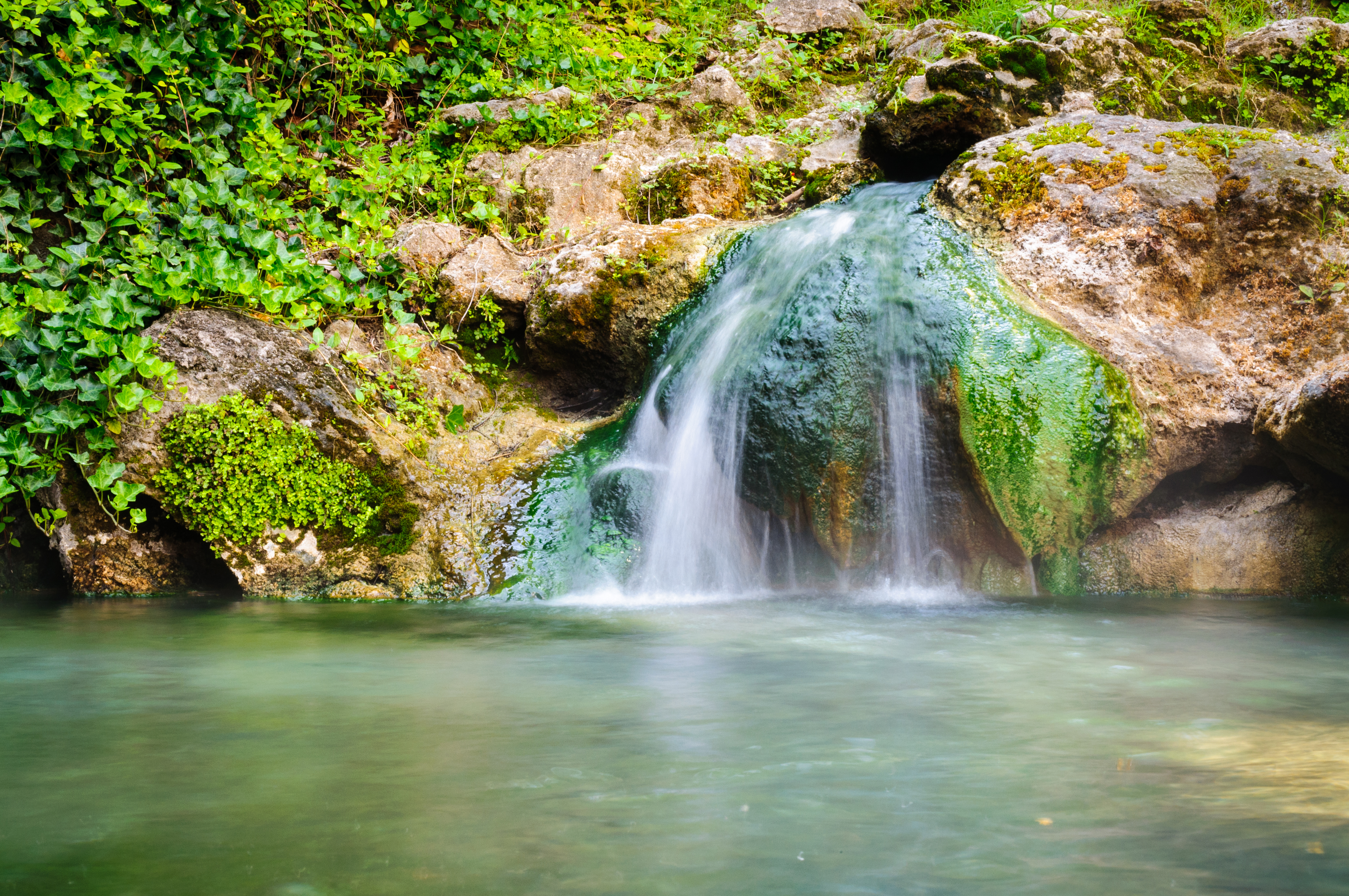
CHECK OUT: 12 FANTASTIC Hot Springs National Park Facts
1. Little Rock Central High School National Historic Site
As the #1 Arkansas Landmark, More Than Just Parks has selected a place which played a pivotal role in the battle for civil rights and racial equality in America. Our #1 site is Little Rock Central High School National Historic Site.
In 1957, Little Rock Central High School became the center of national attention when nine African American students, known as the Little Rock Nine, attempted to integrate the school, which was previously all-white.
The students were met with intense opposition from white segregationist protesters and were initially prevented from entering the school by the Arkansas National Guard, which was under the control of Governor Orval Faubus.
The Little Rock Nine’s efforts to integrate Central High School received national attention and sparked a broader conversation about civil rights and racial integration in America. Eventually, President Dwight D. Eisenhower ordered federal troops to protect the students and enforce their right to attend the school.
Today, the Little Rock Central High School National Historic Site is home to a museum and visitor center that showcases the history of the school and the civil rights movement. Visitors can explore exhibits related to the Little Rock Nine and learn about their experiences and the impact their actions had on American history.

The Only Functioning High School To Be Part Of A National Historic Site
Central High is the only functioning high school to be located within the boundaries of a national historic site. There is a museum across the street which depicts the struggle through moving exhibits and powerful photos.
In 2007, a visitor center opened to coincide with the 50th anniversary of the desegregation crisis. It tells the story of the crisis through interpretive panels, artifacts, news clippings, photographs and original audio, and video recordings.
You don’t have to be a history buff to be moved by this place and what it represents. Imagine what it would have been like to walk into that school in 1957 especially if you were a person of color.
CHECK OUT: 10 BEST Civil Rights Sites In America
Things To Do
Here are some things to do at the site:
- Take a guided tour: Visitors can take a ranger-led tour of the historic school and learn about the events that occurred there during the Civil Rights Movement.
- Visit the Visitor Center: The Visitor Center has exhibits that detail the history of the school and the events that occurred there, as well as a film that provides an overview of the Civil Rights Movement.
- Walk the grounds: Visitors can walk around the exterior of the school and see the commemorative statues and markers that detail the events that occurred there.
- Attend a special event: The site hosts several special events throughout the year, including lectures, panel discussions, and commemorative ceremonies.
- Visit the Civil Rights Memorial: The memorial is located across the street from the school and commemorates the events that occurred during the Civil Rights Movement in Little Rock.
- Take a driving tour: Visitors can take a driving tour of other significant sites in Little Rock that played a role in the Civil Rights Movement.
- Attend a ranger-led program: The site offers ranger-led programs that cover a variety of topics related to the Civil Rights Movement and the history of the school.
- Explore the nearby museums: Little Rock has several museums that cover the history of the Civil Rights Movement in Arkansas, including the Mosaic Templars Cultural Center and the Arkansas Civil Rights Heritage Trail.

CHECK OUT: 20 BEST Black History Sites In America For You To Visit
Map Of Arkansas Landmarks
List Of Arkansas Landmarks
- Little Rock Central High School National Historic Site
- Hot Springs National Park
- President William Jefferson Clinton Birthplace Home National Historic Site
- Buffalo National River
- Pea Ridge National Military Park
- Crater Of Diamonds State Park
- Fort Smith National Historic Site
- Arkansas Post National Memorial
- Blanchard Springs Caverns
- Toltec Mounds Archaeological State Park
- Louisiana Purchase State Park
- Rohwer Relocation Center Memorial Cemetery
- Arkansas Inland Maritime Museum
- Parkin Archeological State Park
- Crystal Bridges Museum of American Art
Why Trust Us About Arkansas Landmarks?
We’re Jim Pattiz and Will Pattiz, collectively known as the Pattiz Brothers and we absolutely LOVE the national parks.
You should probably know that we don’t just make this stuff up out of thin air. We’ve spent our entire adult lives exploring and filming America’s national parks and public lands.
We’ve worked with the National Park Service, the Department of Interior, USDA, U.S. Forest Service, and more for years creating films on important places and issues. Our work has been featured in leading publications all over the world and even some people outside of our immediate family call us experts on the national parks.
And, in 2018, our father – having spent a lifetime teaching history – joined us so that he could help us to tell the stories behind these amazing places.
Meet The Parks Brothers
We Hope You’ll Follow Our Journey

Our goal here at More Than Just Parks is to share the beauty of America’s national parks and public lands through stunning short films in an effort to get Americans and the world to see the true value in land conservation.
We hope you’ll follow our journey through the parks and help us to keep them the incredible places that they are. If you’re interested in joining the adventure then sign up below!
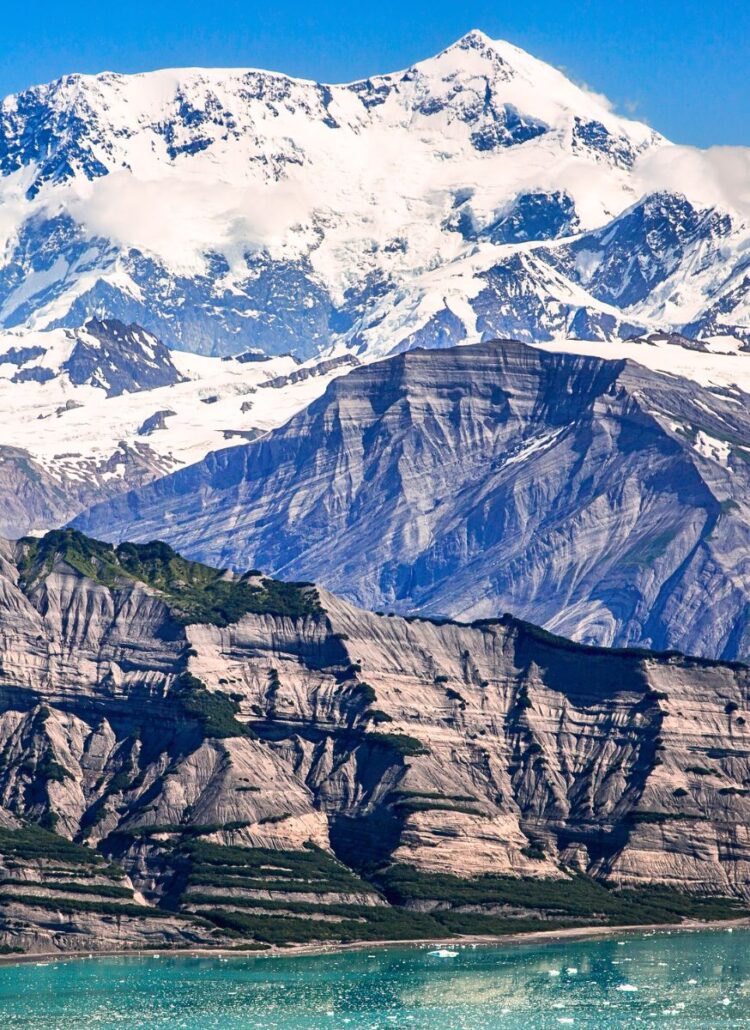

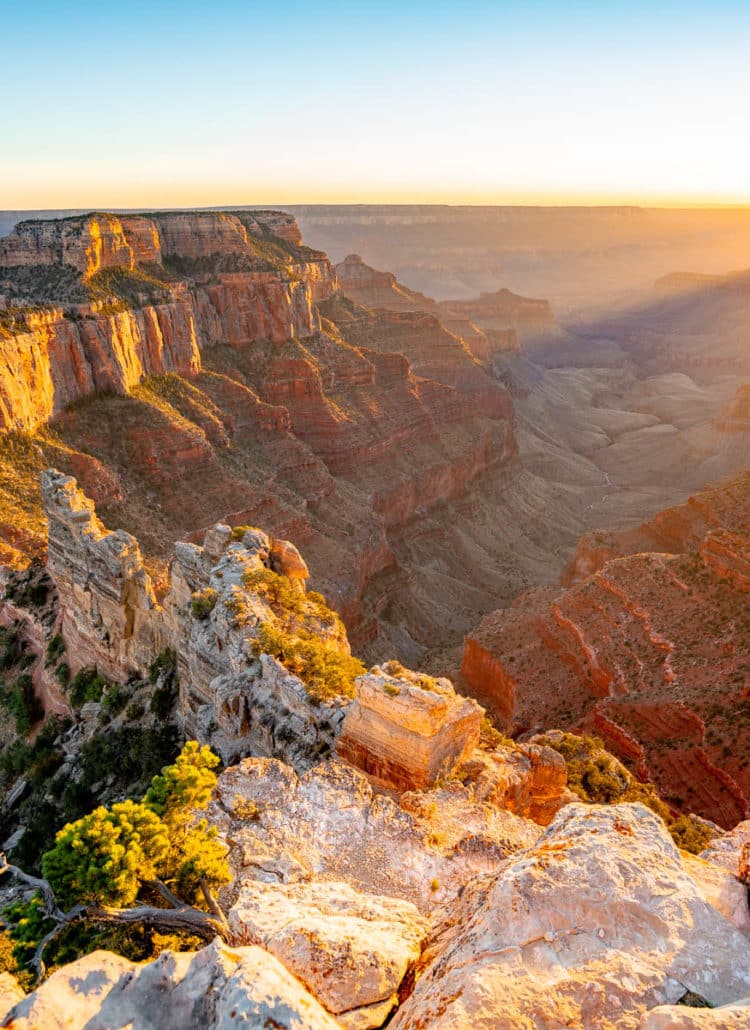
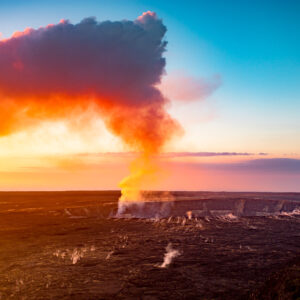

Leave a Reply